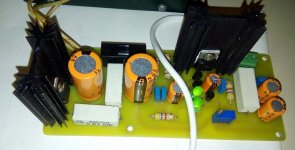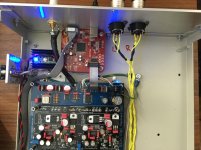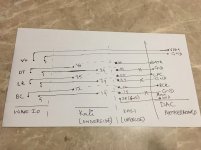Ok here's an odd one. I've implemented 4 Kali reclockers with Wave IO boards and DDDacs and all have run successfully with no issues. All have been implemented leaving the Kali floating with no earth connection and simply bck, lck and data connected.
I then removed the Kali board from my own DAC to use in another DAC and installed a new Kali board.
This board works perfectly with my MacBook Pro but refuses to work with my Mac Mini. The lock light doesn't come on on the Kali board and all I get is some crackling.
I've tried various earthing schemes others have used but nothing makes any difference.
Any ideas anyone?
Hey there. Today, I tried connecting Kali in between the waveio and the dddac motherboard but go no output. The Kali is not properly engaged I believe.
Before I even get into the troubleshooting mode, tell me does this configuration even work with the older Red DDDAC motherboard?
Hey there. Today, I tried connecting Kali in between the waveio and the dddac motherboard but go no output. The Kali is not properly engaged I believe.
Before I even get into the troubleshooting mode, tell me does this configuration even work with the older Red DDDAC motherboard?
The red board is tricky with the Kali. The passive half clock delay does not jive well with the Kali. I had better luck with the blue board, but still had mixed results with some Kali boards from different production batches.
I2S is very sensitive to cable length. I oriented the Waveio a close as possible to the dac board and made a short cable to connect them. Maybe 2” long. I’m not sure how much you can gain if you need to use longer cables to insert the Kali into the I2S signal path.
Perhaps if you can orient things for minimum cable length to dac board it will help.
Perhaps if you can orient things for minimum cable length to dac board it will help.
Attachments
Thanks guys. A quick update. I followed Juancho's post #6891 and advanced to get the Kali engaged (now the Lock light and the appropriate sampling frequencies light up properly). However, there is a crackling sound coming predominantly from the left channel. It is bad and unacceptable. I got this previously as well when I was using the Kali with Rpi+Allo Isolator combo, however, I was able to eliminate the same after experimentation with ground wires connected in several different manners.
I will play around with connecting all/some ground wires between wave io and kali and between kali and the red motherboard and report my findings.
Also, yes I am aware of the ill effects of long wires used in I2S signal paths.
I will play around with connecting all/some ground wires between wave io and kali and between kali and the red motherboard and report my findings.
Also, yes I am aware of the ill effects of long wires used in I2S signal paths.
Hi Kartick,
Keep us posted on that.
Thanks
David
Hey David,
Here is an update: IT WORKS!!! Haha, pardon the caps but I was a bit excited to make it work after numerous tries. So many flimsy i2s wires were running all over the place in that box made me go nuts. However, in the end it worked out.
How I made it work: A lot of hit and trial basically. The issue was with how I was connecting the ground wires. WaveIO's DT, LR, BC and their grounds to be connected with Kali's inputs and WaveIO's V+ and corresponding ground were engaged with V and ground on the Red motherboard's inputs.
Without getting into the sound quality aspects for now, I would like to share the following points:
- Even if one has the old Red motherboard, Kali works in between the Wave IO and DAC Motherboard without any problems. No static or noise when the music is being played. No sense of any delays or timing issues as well.
- The stock length of i2s wires is not a problem to get this setup going. I can't yet comment if making the length shorter will improve anything related to the SQ.
- I don't think the make of Kali or different batches have a part to play in this. I believe all pieces should work. I relate this claim to my observation from the past where I was getting crackles when Kali was being paired with a RPI. Again, playing around with the ground cables had resolved this for me. Other people who faced this crackling noise issue should try this before attributing it to the make/batch of Kali.
Further investigation required: I noticed that there is a slight audible hiss (don't know if it is quantization noise or something) coming when WaveIO and Kali operate in tandem. This hiss is not bothersome when music is playing but it is present even if the amplifier's volume is set to 0). Would be interested to find out why and how to get that to vanish.
Hope this helps.
Last edited:
Here is an update: IT WORKS!!! ... How I made it work: A lot of hit and trial basically. The issue was with how I was connecting the ground wires.
Great! But HOW did you connect the wires to make it work?
I don't think the make of Kali or different batches have a part to play in this. ... Other people who faced this crackling noise issue should try this before attributing it to the make/batch of Kali.
I did try a lot of things with the grounding. In the end, it really was an issue related to different Kali batches in my case. Swapping out one Kali for another board from a different batch made all the difference.
Hi KartickHey David,
Here is an update: IT WORKS!!! Haha, pardon the caps but I was a bit excited to make it work after numerous tries. So many flimsy i2s wires were running all over the place in that box made me go nuts. However, in the end it worked out.
How I made it work: A lot of hit and trial basically. The issue was with how I was connecting the ground wires. WaveIO's DT, LR, BC and their grounds to be connected with Kali's inputs and WaveIO's V+ and corresponding ground were engaged with V and ground on the Red motherboard's inputs.
Without getting into the sound quality aspects for now, I would like to share the following points:
- Even if one has the old Red motherboard, Kali works in between the Wave IO and DAC Motherboard without any problems. No static or noise when the music is being played. No sense of any delays or timing issues as well.
- The stock length of i2s wires is not a problem to get this setup going. I can't yet comment if making the length shorter will improve anything related to the SQ.
- I don't think the make of Kali or different batches have a part to play in this. I believe all pieces should work. I relate this claim to my observation from the past where I was getting crackles when Kali was being paired with a RPI. Again, playing around with the ground cables had resolved this for me. Other people who faced this crackling noise issue should try this before attributing it to the make/batch of Kali.
Further investigation required: I noticed that there is a slight audible hiss (don't know if it is quantization noise or something) coming when WaveIO and Kali operate in tandem. This hiss is not bothersome when music is playing but it is present even if the amplifier's volume is set to 0). Would be interested to find out why and how to get that to vanish.
Hope this helps.
If I understand you correctly you are saying that you connected Waves earth's to Kali's earth's then Kali's earth's to the mainboard?
Do correct me if that's wrong. A sketch of the circuit would be helpful
David
Thanks. It's a little different so I'll give be it a tryHere you go guys.... pretty much the same thing that you helped me with.
Warning: i am quite bad at these diagrams, so if there is any confusions, let me know.
David
Here you go guys.... pretty much the same thing that you helped me with.
Warning: i am quite bad at these diagrams, so if there is any confusions, let me know.
How and where did you connect the GNDs of the PSUs (WaveIO, Kali, DDDAC)?
How and where did you connect the GNDs of the PSUs (WaveIO, Kali, DDDAC)?
WaveIo and dddac have their independent psu ground wires which then attach to the ac input plug’s common ground.
Kali at this moment is being powered by the Allo wallwart supply so it should take care of the grounding.
That's essentially how I run my set up but with onboard separate PSUs for Wave, Kali and DDDacWaveIo and dddac have their independent psu ground wires which then attach to the ac input plug’s common ground.
Kali at this moment is being powered by the Allo wallwart supply so it should take care of the grounding.
WaveIo and dddac have their independent psu ground wires which then attach to the ac input plug’s common ground.
Take a look at the GND connection:
AC plug --> chassis --> Wave IO PSU --> Wave IO board --> Kali --> DDDAC --> DDDAC PSU --> chassis --> AC plug
That looks like a big fat ground loop to me in the digital signal chain. I don't know, but I don't think this is good.
Kali at this moment is being powered by the Allo wallwart supply so it should take care of the grounding.
Most wall warts don't have a safety earth GND, so I guess the Kali PSU does not have its own GND. The Kali has two GND connections (one to the Wave IO and one to the DDDAC) to the chassis / AC plug GND.
I think this is being over complicated. There is a signal ground at the AC plug inlet. That is where the independent ground connections of the two separate power supplies of wave io and dddac go and meet. Think that circuit is complete.
Now, the Kali is connected to one of its ground to the wave io as well as with the dddac. The wall supply should have a safety ground.
I would say go ahead and try the integration in the way it worked for me. Pick the brains of electronic experts in parallel to check if grounding is a concern. If yes, then let's work towards it. But at least see if you get audio in this way.
Now, the Kali is connected to one of its ground to the wave io as well as with the dddac. The wall supply should have a safety ground.
I would say go ahead and try the integration in the way it worked for me. Pick the brains of electronic experts in parallel to check if grounding is a concern. If yes, then let's work towards it. But at least see if you get audio in this way.
After getting the Kali to work successfully, I was wanting to measure all voltages correctly off of the DAC. Here is what I observed:
Vout from Right channel: 2.70 volts
Vout from Left channel: 2.66 volts
Q1: Is this a big difference? If yes, what could it translate into in terms of listening our audio output?
Q2: How can I get the Vout from left to also reach to 2.7V (get it to increase by .04V)? (afaik all the rload resistor values are correct and matching with each other, so no reading differences there and these go out to the Cinemags CMLI 15/15B).
Vout from Right channel: 2.70 volts
Vout from Left channel: 2.66 volts
Q1: Is this a big difference? If yes, what could it translate into in terms of listening our audio output?
Q2: How can I get the Vout from left to also reach to 2.7V (get it to increase by .04V)? (afaik all the rload resistor values are correct and matching with each other, so no reading differences there and these go out to the Cinemags CMLI 15/15B).
After getting the Kali to work successfully, I was wanting to measure all voltages correctly off of the DAC. Here is what I observed:
Vout from Right channel: 2.70 volts
Vout from Left channel: 2.66 volts
Q1: Is this a big difference? If yes, what could it translate into in terms of listening our audio output?
Q2: How can I get the Vout from left to also reach to 2.7V (get it to increase by .04V)? (afaik all the rload resistor values are correct and matching with each other, so no reading differences there and these go out to the Cinemags CMLI 15/15B).
Offset is a concern for transformers. See post 6893. I explain how I would go about zeroing out the offset. Is it important? A lot depends on the transformer you are using. Ideally there should not be any DC voltage across the transformer primary. I looked at the cinemag site and they don’t list the DC Resistance for the windings. Looking at the similar 10k Jensen transformers the primary is1.45kohms. So for the Jensen a 40mv dc imbalance would result in .04/1.45k =27.6ua dc. You can contact Cinemag and ask if 40mv is going to cause any issues. You may feel that your output resistances are matched close enough but if you do the calculation in post 6893 you will see that it is a very small difference.
I have a single dac board in my setup and the offset is only 3-4mv.
- Home
- Source & Line
- Digital Line Level
- A NOS 192/24 DAC with the PCM1794 (and WaveIO USB input)


